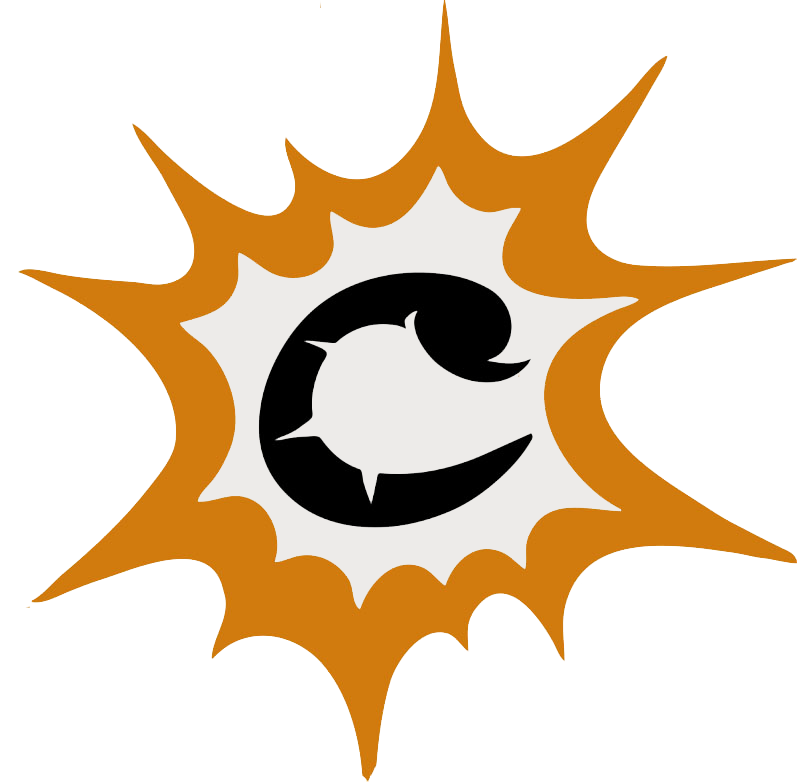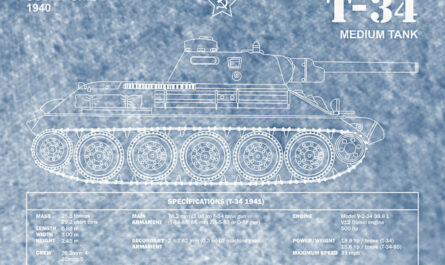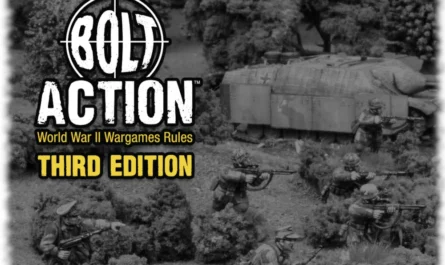You’ve just bought your first Bolt Action miniatures and you’re ready to dive into the game. But before anything else, they need to be assembled! Each sprue — no matter the nation — comes packed with options, and for newcomers, it’s easy to feel lost when deciding what to build. Here’s a quick guide to help you get started and avoid beginner mistakes.
Anatomy of a Bolt Action sprue
Typically, each sprue includes six bodies: four standing and two kneeling. There’s a ton of weapon, arm and pose options to choose from. Every box also comes with a small leaflet to help you identify the different weapons included.
Now comes the main source of confusion for most beginners (and I was one of them not that long ago):
What should you build first?
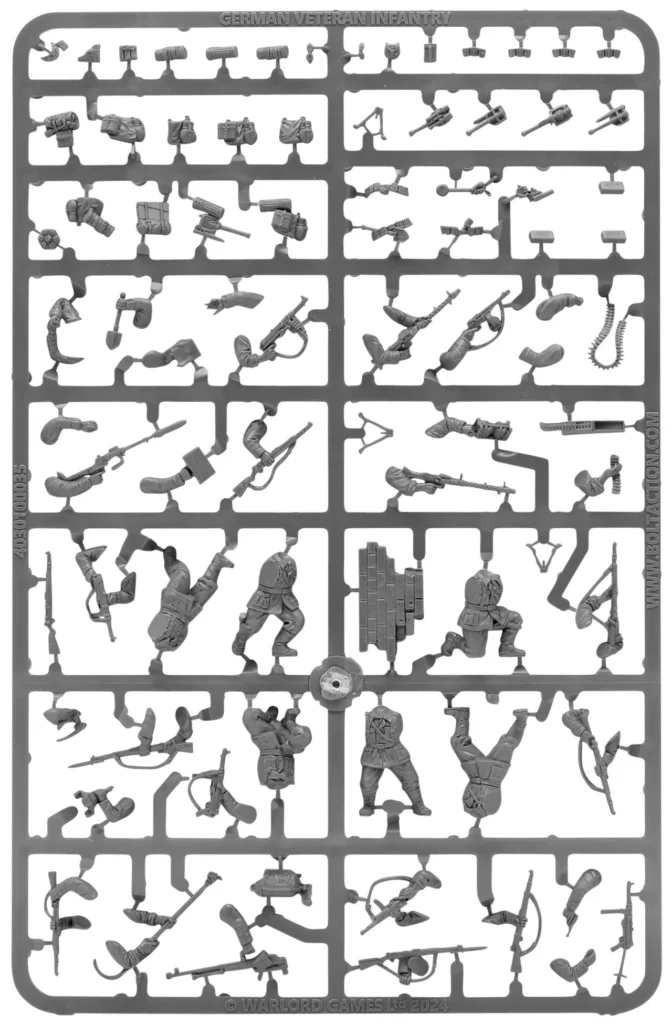
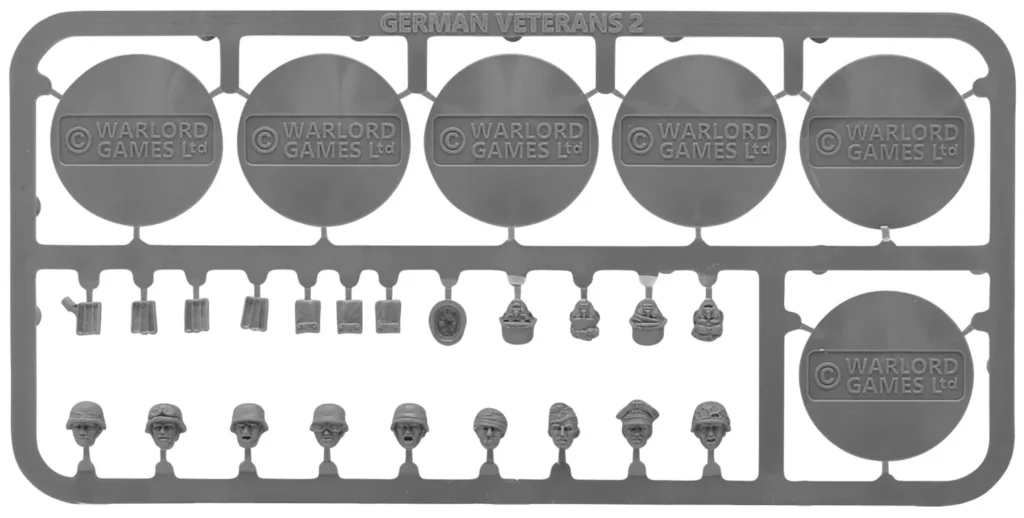
The goal of your first Bolt Action builds
Bolt Action lets you build full army lists with company HQs, platoon commands, spotters, medics and all sorts of specialist options. But your first goal should be to build a small force to learn the game mechanics.
To keep things simple, start with two sprues — that’s 12 soldiers.
From those 12 soldiers, build a platoon leader with a rifle and his runner, also armed with a rifle. Your officer can easily stand out on the tabletop with a bare head, for instance. You can equip him — and his men — with a pistol or an SMG. Keep in mind that officers don’t usually fight on the front line; their main job is to issue orders. Still, an SMG gives your lieutenant a dangerous edge if things get close and personal.
That leaves you with 10 figures.
Make two squads of five riflemen each, including a sergeant (NCO) in every unit. Just like your officer, the NCO can be equipped with an SMG to make him easy to spot on the battlefield. Warlord Games’ sprues usually include several alternate heads, which makes it simple to give your squad leaders a bit of character.
Once everything is assembled — congrats! You now have your very first Bolt Action platoon ready for battle, complete with its infantry squads.
What to do with all that?
You’re still a long way from a full 1250-point army, but with these 12 miniatures — and assuming you’ve got a gaming buddy — you can already play your very first match.
- You’ll need one order die per unit: one for your platoon leader and two more for your rifle squads.
- A small battlefield (around 90 × 90 cm / 3 × 3 ft) with a few pieces of terrain to block line of sight.
- And, of course, an opponent with a similar setup so both sides are evenly matched.
You can now start experimenting with the orders system and the core game mechanics in a simplified way — shooting sequences, movement, reactions — without worrying about the many other advanced options Bolt Action has to offer.
At this early stage, the scenario and victory conditions don’t really matter. What’s important is getting used to the flow of the game, learning how the orders work, and just enjoying a few stress-free training sessions before jumping into more serious battles later on.
The evolution of your squads
Once you’ve played a few games, you’ll probably want to expand your two initial squads. Depending on which nation and wartime period you’re building, you’ll have different options available. But let’s keep things simple for now — you’re still learning.
Add two soldiers to one of your squads and arm them with an LMG. You’ve just created your first fire support squad! The other squad will then naturally become your assault squad.
Give your assault squad a few SMGs to make them lethal at short range. At this point, you’ll need to start checking the rules for squad composition in your army book or the core rulebook — page 198 in the main rulebook is a good place to start. There you’ll find how each nation organizes its units and what options are allowed.
Bolt Action is pretty flexible when it comes to soldier experience and abilities. Within the same squad, you can test out how different experience levels — Inexperienced, Regular, or Veteran — affect gameplay. Use this small setup as your personal lab to experiment and really understand how the game system works. You’ll be surprised how much depth you can explore with just 16 miniatures!
What’s next?
Now it’s time to create your company commander. In some box sets, especially the starter armies, you’ll find resin models that represent specific characters or officers. Go ahead and glue one onto a base, then add one or two aides armed with rifles or SMGs to accompany him.
This adds another order die to your force, along with all the benefits of a company HQ — improved morale rolls and a wider command range compared to your platoon leader.
By now, you’ll have a few games under your belt, you’ll understand how the Bolt Action system flows, and you’ll probably be eager to explore more units and tactical options.
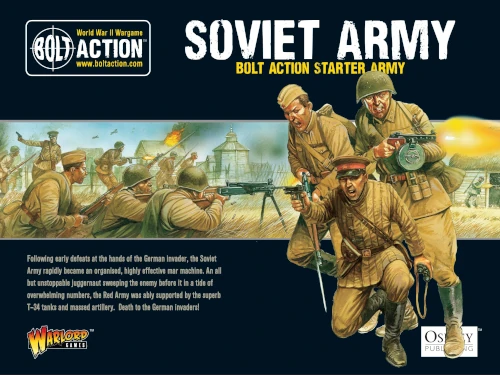
An overview of the platoons available in Bolt Action
Bolt Action offers a wide variety of platoons, each with its own role and personality. Let’s take a look at what they bring to the battlefield!
Rifle platoon
This is the backbone of any company. Every Bolt Action army list includes at least one rifle platoon, usually built around the following structure:
- 1 platoon commander
- 2 rifle squads
That’s exactly what I suggested earlier — the perfect setup for testing the game!
You can further customize this platoon in many ways:
- Add up to two more rifle squads to give it more punch.
- Add a medic to keep your men in the fight longer.
- Add a forward observer to call in artillery or air strikes.
- Add a sniper team.
- Add an anti-tank team.
- Add one or two light mortars.
- Add troop transports to move your soldiers quickly across the battlefield.
This type of platoon is very versatile. You can build it for assaults, for sustained fire support, or as a fast-moving strike force using transports. It’s a flexible foundation that can evolve with your playstyle.
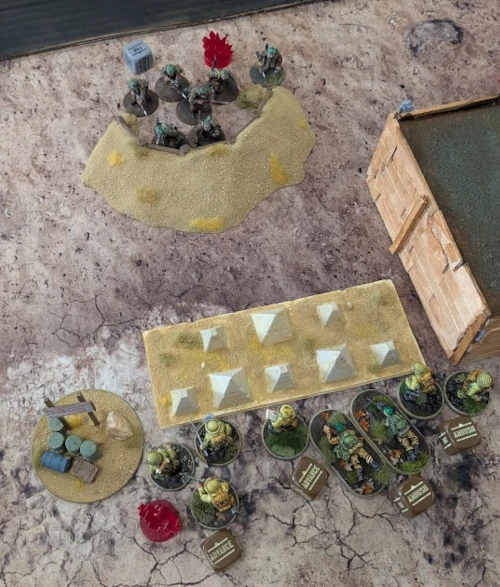
Heavy weapons platoon
This platoon includes a command element and several specialist teams — usually machine guns and mortars. You can mix and match as you like: two MMG or HMG teams, a few mortar crews, or even some anti-tank units. In fact, you can field up to three mortars and three machine-gun teams, plus a few anti-tank squads if you want to make enemy armor sweat.
This platoon shines when you want to deploy medium or heavy mortars, machine-gun teams, or anti-tank hunters like bazooka or Panzerschreck crews. Personally, I consider it a must-have, even though it tends to be less mobile. It won’t fit every scenario — especially those with lots of movement — but when it does, it can completely dominate the table.
A battery of mortars hidden behind terrain can rain down shells all game long, guided by spotters, while your MMGs lock down key fire lanes and suppress the enemy. Slow but deadly — that’s the essence of this platoon.
Artillery platoon
If you’ve got guns, this one’s for you. Though less mobile than tanks, artillery brings serious firepower to the table — perfect for breaking up massed infantry or taking out enemy armor from afar.
These units take some practice to use effectively, so I’d recommend leaving them out of your first few lists until you get comfortable with the basics.
Like the heavy weapons platoon, artillery units don’t work equally well in every scenario. But against an armored assault company, for example, they can be invaluable. Multiple anti-tank guns cost far less than a single tank and can provide a strong defensive backbone — especially in historical or narrative games.
Armored platoon
At 1250 points, you won’t be able to field a full tank platoon — which is a shame for armor enthusiasts like me!
The great thing about the third edition is that you can now include up to five tanks in a single rifle platoon, ten tanks if you’ve got two rifle platoons, or even fifteen with three — and so on.
Each armored platoon must include at least two vehicles: a command tank and another armored vehicle. Depending on your army, several command tank options are available — and most regular tanks can be upgraded to command versions for just 10 points.
Imagine an army with only 16 infantrymen and 5 tanks. That’s a force your opponents won’t forget in a hurry — unless, of course, they’re tank lovers too!
One important detail: to field a platoon with powerful tanks, you’ll probably need to go beyond 1250 points. However, if you stick to vehicles under 200 points, it’s perfectly possible to include a light or medium tank platoon in a standard-sized list. For German players, that usually means Early War lists with lighter armor.
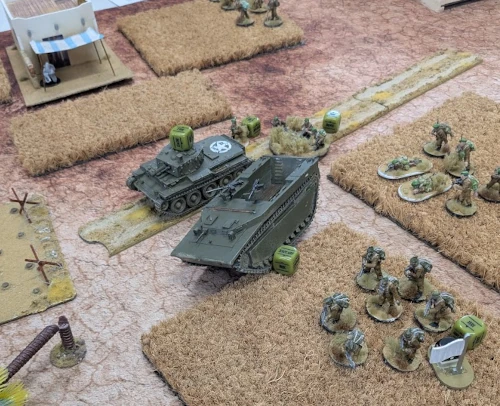
Reconnaissance platoon
This is the only platoon that must include vehicles for all its infantry. These transports must have the Recce rule — if they don’t, you can give it to them for an extra 10 points per vehicle.
It’s a great option for unlocking an additional forward observer, adding engineer squads to your list, and including an anti-tank team for some extra bite.
This platoon shines in missions where speed and mobility are key — perfect for racing toward objectives or outflanking a defensive position.
Just remember: vehicles come at a cost, so a recon platoon will naturally be more expensive than a purely foot-based force.

Patience and progress
Start your Bolt Action journey with simple tactical choices. Then, over time, add new units and upgrades as your collection — and your confidence — grows. Let your playgroup’s preferences guide you, too. Everyone has their own way to enjoy Bolt Action.
Don’t try to play everything at once. The game is deep, and trying to master every rule from the start can be overwhelming. Add options gradually — there’s no rush! It’s far better to make a small mistake in a quick 30-minute match than in a 4-hour marathon game.
The beauty of Bolt Action lies in how free and creative the army-building process is. From the same core structure, you can craft companies that play completely differently. That freedom is what made me fall in love with the game in the first place.
Learn to play Bolt Action
Learn to play Bolt Action is a French-language video series (currently three episodes) that lays the groundwork for understanding the game’s key mechanics.
This series is created by Benoist from Wargame Miniature Tuto — an excellent resource for French-speaking players looking to get a solid grasp of the Bolt Action system.
Bolt Action glossary
NCO = Squad Leader: The NCO is in charge of their squad, giving orders and maintaining the unit’s morale.
SMG: Short for Submachine Gun. Compact, fast-firing weapons with short range. In Bolt Action, they fire 2 dice per shot, have a 12-inch range, and benefit from the Assault special rule.
The Assault rule provides two effects:
- No -1 penalty when firing under an Advance order.
- Re-roll damage dice in close combat.
MMG: Stands for Medium Machine Gun. These light support weapons pack serious firepower for their size and are great for covering advancing troops.
HMG: Short for Heavy Machine Gun. Usually mounted on vehicles, they come with a +1 penetration bonus. They’re brutal against infantry and can even threaten lightly armored vehicles.

Support us via Maxi Rêves ✨
Help us promote lesser-known wargames and grow their communities. Order your miniatures from Maxi Rêves using the code MAXITC and support our mission!
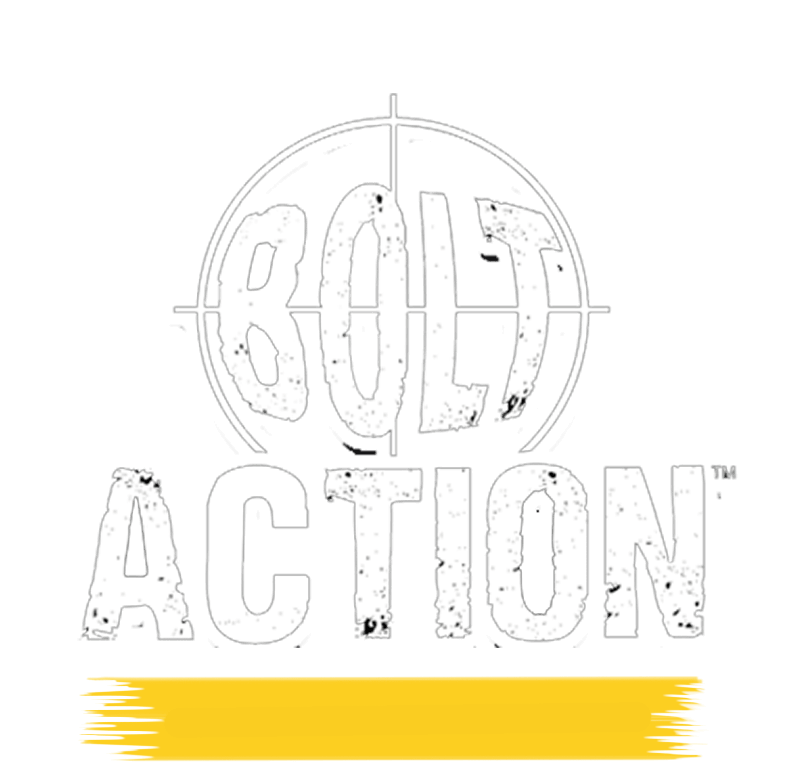
Find Bolt Action players
Join your country’s Bolt Action Discord community and connect with players nearby.
